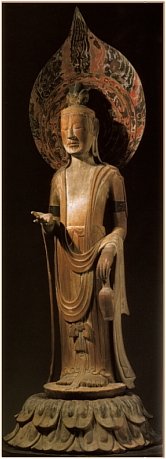Kokūzō Bosatsu 虚空蔵菩薩 Bodhisattva of Wisdom & Memory
Kokūzō is especially important to Japan’s Shingon sect of Esoteric Buddhism (Mikkyō 密教). Kokūzō symbolizes the "vast and boundless" Buddha wisdom that permeates the universe. In Japan, believers pray to Kokūzō to grant them wisdom on their quest toward enlightenment. They also pray to Kokūzō to improve their memory, technical skills, and artistic talents.
Origin India
Kokūzō is often translated as Space Repository or Sky Repository (空 = Space, Sky; 蔵 = Repository), for Kokūzō’s wisdom and compassion are said to be as boundless as the sky; Kokūzō personifies infinitely vast wisdom and compassion. One who removes obstacles, one who helps people recognize & overcome their errors, one who encourages the practice of the Six Perfections, one who fulfills all wishes.
Invoked in the Gumonjihō 求聞持法, an esoteric rite to improve one’s memory that involves reciting Kokūzō’s morning star mantra. Kūkai 空海 (774 - 835), the founder of Japan’s Shingon sect, practiced this rite prior to achieving enlightenment.
Identified with the planet Venus (Myōjō 明星) and with Aruṇa (charioteer of the sun in Hindu lore). Aruṇa also represents dawn. By tradition, the founder of Japan’s Shingon sect -- Kūkai -- attained enlightenment in the early dawn when Kokūzō appeared as the morning star and pierced Kūkai’s mouth. <source Sacred Kōyasan>
One of 13 Deities 十三仏 (Jūsanbutsu) of Japan’s Shingon Sect; in this role, Kokūzō presides over the memorial service held on the 32nd anniversary after one's death.
In the Womb World Mandala (Jp. = Taizōkai 胎藏界, Skt. = Garbhadhātu), Kokūzō appears as the central deity in the Court of Space (Kokūzō-in 虚空蔵院) wearing a crown of five gems, with right hand holding a sword and left a lotus topped with a jewel. Kokūzō also appears in the Court of Shaka (Shakain 釈迦院) as Shaka’s right-hand attendant; in this role, Kokūzō graps a fly whisk in one hand and a lotus topped with a green gem in the other.
In the Diamond World Mandala (Jp. = Kongōkai; Skt. = Vajradhatu), Kokūzō appears as Kongōhō 金剛宝菩薩 (Skt. = Vajraratna), one of the 16 Great Bodhisattva; Kokūzō is also counted among the 16 Deities of the Auspicious Aeon.
Appears in five forms known as the Godai Kokūzō Bosatsu 五大虚空蔵菩薩 (Five Great Kokūzō); the five are manifestations of the Five Buddha (Gobutsu 五仏) and are invoked in the Godai Kokūzōhō 五大虚空蔵法, an esoteric rite for fulfilling wishes and averting misfortune.
Appears as the central object of worship in the Kokūzō Bosatsu Mandara 虚空蔵菩薩曼荼羅.
In Japan, Kokūzō is also worshipped as the patron of craftspeople and artisans.
On Japan’s Honshu island, children who are 13 years of age still follow the custom of paying homage to Kokūzō in the hopes of becoming more intelligent.
Guardian of People Born in the Zodiac Years of the Ox and the Tiger. Click here to find your patron deity.
English Translations for Kokūzō
Womb of the Sky
Bodhisattva of Space (Wisdom of Emptiness)
Vast & Boundless Vessel of Buddha’s Wisdom
Bodhisattva of All-Encompassing Wisdom.
Space / Sky Repository (also Space / Sky Treasury)
Guardian of the Treasury of All Wisdom & Achievement
kokuzo-mantra-sanskrit-viiblematra-akasagarbha oṃ vajra ratna oṃ trāḥ svāhā (transliteration) Sanskrit version. Script courtesy visiblemantra.org.
Kokuzo Bosatsu Mantra in Japan ‚¨‚ñ ‚΂´‚ç ‚ ‚炽‚ñ‚Ì‚¤@‚¨‚ñ ‚½‚ç‚ ‚»‚í‚© on bazara aratannō on taraku sowaka Japanese version of above Sanskrit mantra.
A shortened version of the mantra is: on basara aratana kan on basara aratana un おん ばさら あらたな かん おん ばさら あらたな うん.
Top of Kokuzo Page
Esoteric Rite to Improve One’s Memory
Morning Star Mantra, Kokūzō as the Morning Star
Kokūzō was introduced to Japan in the late Nara period (circa 790 AD) as part of an esoteric rite to improve one's memory, and even today Kokūzō is venerated as a deity who bestows intelligence on
devotees. The esoteric rite, known as Gumonjihō or Gubunjihō 求聞持法 (Chn. = Qiúwén chífǎ), comes from a sutra known in Japan as Kokūzō Bosatsu nō man shogan saishō shin darani gumonji
hō 虛空藏菩薩能滿諸願最勝心陀羅尼求聞持法 (Taishō Canon #1145). It was first translated into Chinese in 716 CE, and may be loosely translated as Kokuzo Bosatsu's power-filled, wish-fulfilling, supreme mind dharāṇi technique for seeking, hearing, and retention.
Kūkai 空海 (774–835), the patriarch of Japan’s Shingon sect, was taught to recite the Gumonji-hō mantra during his training as a teenager. Since the sutra promises devotees
who earnestly recite the mantra that Kokūzō will appear to them as the morning star, the chant is also called the Morning Star mantra. Kūkai reportedly attained enlightenment in the early dawn at Cape
Muroto (Shikoku island) while reciting the mantra, and as promised, Kokūzō appeared to him in the
form of the morning star. Kūkai himself writes in the Sangō Shiiki 三教指帰 (Guide to the Three Teachings, 797 AD): “The valleys echoed, and the morning star made its appearance.”
Kokuzo Bosatsu - Morning Star Mantra in Sanskrit
namo ākāśagarbhaya oṃ ārya kamari mauli svāhā (transliteration)
Morning Star Mantra in Sanskrit. Script courtesy visiblemantra.org.
Kokuzo Bosatsu - Morning Star Mantra, ‚Ì‚¤‚Ú‚¤ ‚ ‚«‚Ⴕ‚á ‚«‚á‚ç‚΂⠂¨‚ñ ‚ ‚è‚«‚á ‚Ü‚è ‚Ú‚è ‚»‚í‚© nōbō akyasha kyarabaya on arikya mari bori sowaka
Japanese Version of Morning Star Mantra.
Kōbō Daishi 弘法大師 (Kūkai’s posthumous title, lit. = Great Teacher Kōbō), said people who chant this mantra one million times will gain the ability to remember and understand any Buddhist text.
The Gumonjihō sutra itself says: “If people recite the mantra of Kokūzō one million times, in accord with the teachings [in this sutra], they will achieve the ability to memorize the words and understand the real meaning of all scriptures they study.
